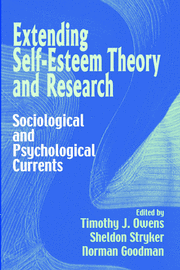Book contents
- Frontmatter
- Contents
- List of Contributors
- SECTION ONE THE FRAME
- SECTION TWO CONCEPTUAL AND METHODOLOGICAL ISSUES
- 3 Theorizing the Relationship Between Self-Esteem and Identity
- 4 Measuring Self-Esteem: Race, Ethnicity, and Gender Considered
- 5 The Self as a Social Force
- 6 Self-Certainty and Self-Esteem
- SECTION THREE SOCIAL AND LIFE COURSE CONTEXTS OF SELF-ESTEEM
- SECTION FOUR SELF-ESTEEM AND SOCIAL INEQUALITIES
- SECTION FIVE SELF-ESTEEM AND SOCIAL PROBLEMS
- Index
6 - Self-Certainty and Self-Esteem
Published online by Cambridge University Press: 24 November 2009
- Frontmatter
- Contents
- List of Contributors
- SECTION ONE THE FRAME
- SECTION TWO CONCEPTUAL AND METHODOLOGICAL ISSUES
- 3 Theorizing the Relationship Between Self-Esteem and Identity
- 4 Measuring Self-Esteem: Race, Ethnicity, and Gender Considered
- 5 The Self as a Social Force
- 6 Self-Certainty and Self-Esteem
- SECTION THREE SOCIAL AND LIFE COURSE CONTEXTS OF SELF-ESTEEM
- SECTION FOUR SELF-ESTEEM AND SOCIAL INEQUALITIES
- SECTION FIVE SELF-ESTEEM AND SOCIAL PROBLEMS
- Index
Summary
If, however, a person has unclear, unstable, uncertain opinions, attitudes, and perceptions of himself – if he simply is not sure what he is like – then he is deprived of his most valuable frame of reference.
(Rosenberg, 1989, p. 153)Many social phenomena – reactions to positive and negative feedback, avoidance of evaluative circumstances – are presumed to reflect individual differences in self-esteem. Discussions of these phenomena often assume that an individual's esteem-relevant thoughts and behaviors can be predicted based on a single number, namely, the individual's level of self-esteem. Some approaches have gone beyond this “point estimate” to a multifaceted conceptualization, measuring self-esteem separately in various domains (e.g., Rosenberg, Schooler, Schoenbach, & Rosenberg, 1995; reviewed by Harter, 1996). Still, the level of self-esteem in each specific area is a single number. Research reviewed in this chapter suggests that understanding people's psychological experiences and predicting their responses requires knowledge not only of their level of self-esteem, but also of the certainty, clarity, consistency, and stability of the self-image.
From his extensive study of adolescents, Rosenberg (1989) concluded that difficulties experienced by low self-esteem individuals often resulted not from low self-esteem per se, but from concomitant self-image disturbances. He viewed self-esteem as one part of a multi-aspect self-image. Self-esteem is reflected in the direction – “whether he [sic] has a favorable or unfavorable opinion of himself” – and intensity – “how strongly favorable or unfavorable these feelings are” – aspects of the self-image (Rosenberg, 1979, p. 24).
Information
- Type
- Chapter
- Information
- Extending Self-Esteem Theory and ResearchSociological and Psychological Currents, pp. 101 - 134Publisher: Cambridge University PressPrint publication year: 2001
Accessibility standard: Unknown
Why this information is here
This section outlines the accessibility features of this content - including support for screen readers, full keyboard navigation and high-contrast display options. This may not be relevant for you.Accessibility Information
- 11
- Cited by
